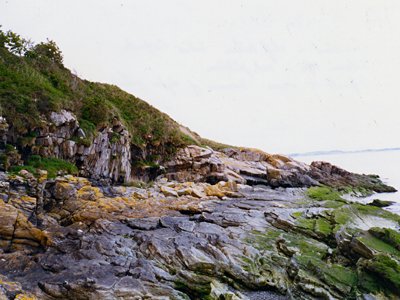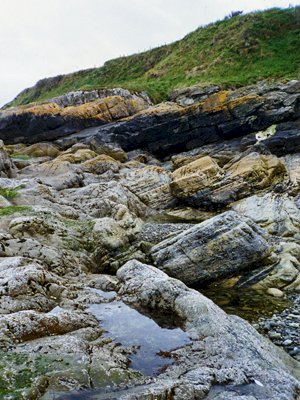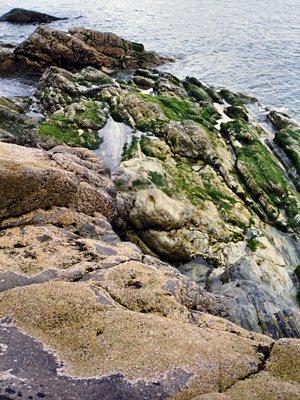Earth Science Conservation Review
| Mournes - Bloody Bridge Cone-sheet | Down |


| Site Type: | Coastal section |
| Site Status: | ASSI |
| Council area: | Newry & Mourne District Council |
| Grid Reference: | J389276,J390271 |
| Google maps: | 54.17904,-5.8726 |
| Rocks | |
|---|---|
| Rock Age: | Tertiary, Silurian (Eocene, Silurian Undifferentiated) |
| Rock Name: | Granite |
| Rock Type: | Hornfels, Porphyry, Quartz porphyry |
| Interest | |
| Other interest: | cone-sheet, Intrusion |
Summary of site:
On the coast immediately east of the Mourne Mountains, in the vicinity of the Bloody Bridge River mouth, a stretch of a cone sheet can be seen crossing the shore and forming a short submerged offshore loop before cutting inland, both north and south, around the flank of the Mourne granites. A cone sheet is an injection of molten rock into a fracture taking the form of an inverted cone and it is always associated with deep-seated masses of molten igneous rocks (magma chambers). The theoretical explanation relates to pressure exerted on the roof of the chamber generating fractures which propagate upwards and outwards into the surrounding rock formation in a conical form. As the fractures open they are immediately filled with high pressure magma from the top of the chamber creating the conical sheet form that gives them their name. Cone sheets normally encircle plutonic igneous rocks such as granites and occur before they are emplaced.
The molten rock injected around the eastern Mournes cooled to form an enormous sheet of quartz porphyry. This rock has the composition of granite but differs in its appearance, exhibiting large rounded crystals, up to a centimetre across, of feldspar with slightly smaller quartzes. The feldspars show a variety of compositions and some have been altered to the clay mineral, kaolinite and fine-grained micas. The groundmass is a medium-grained granite and quartz was the last mineral to solidify, filling the final spaces in the crystal mesh.
The cone sheet was later re-activated and injected a second time by porphyry that can be seen to chill against the first. Later veins of quartz and a porphyritic granophyre (a granite with a groundmass where the quartz and feldspar crystals have grown through each other) cut the cone sheet and at least one vein of aplite (a fine-grained granite squeezed out of the large central mass at a late stage) can be seen.
The cone sheet is injected into slightly altered Silurian sediments (baked to hornfelses) and fragments (xenoliths) have detached from the walls in some places and can be seen suspended in the porphyry.
This cone sheet is part of a system that almost completely encircles the main mass of the three granites of the eastern Mournes.
Access to the outcrops is over a rough and hazardous rocky shore and a case can be made for the creation of a more easily negotiated route.
The molten rock injected around the eastern Mournes cooled to form an enormous sheet of quartz porphyry. This rock has the composition of granite but differs in its appearance, exhibiting large rounded crystals, up to a centimetre across, of feldspar with slightly smaller quartzes. The feldspars show a variety of compositions and some have been altered to the clay mineral, kaolinite and fine-grained micas. The groundmass is a medium-grained granite and quartz was the last mineral to solidify, filling the final spaces in the crystal mesh.
The cone sheet was later re-activated and injected a second time by porphyry that can be seen to chill against the first. Later veins of quartz and a porphyritic granophyre (a granite with a groundmass where the quartz and feldspar crystals have grown through each other) cut the cone sheet and at least one vein of aplite (a fine-grained granite squeezed out of the large central mass at a late stage) can be seen.
The cone sheet is injected into slightly altered Silurian sediments (baked to hornfelses) and fragments (xenoliths) have detached from the walls in some places and can be seen suspended in the porphyry.
This cone sheet is part of a system that almost completely encircles the main mass of the three granites of the eastern Mournes.
Access to the outcrops is over a rough and hazardous rocky shore and a case can be made for the creation of a more easily negotiated route.
| Enlander, I., Dempster, M. & Doughty, P., 2025. Mournes - Bloody Bridge Cone-sheet, County Down, site summary. [In] Earth Science Conservation Review. https://www.habitas.org.uk/escr/summary.php?item=1102. Accessed on 2025-04-03 |
| Previous Site | Next Site |

